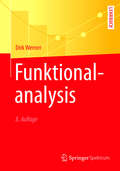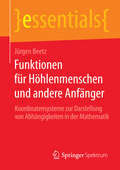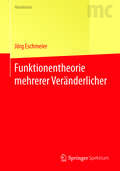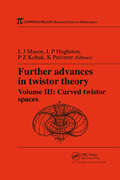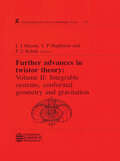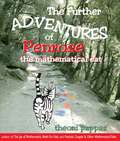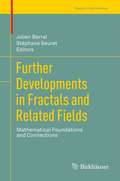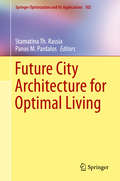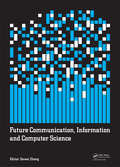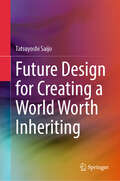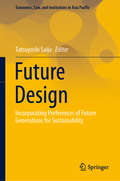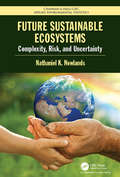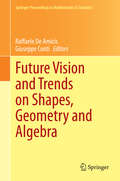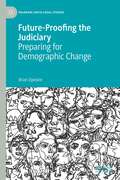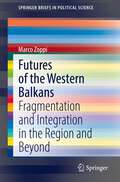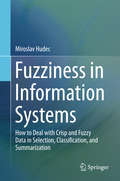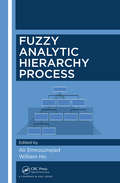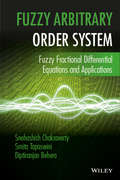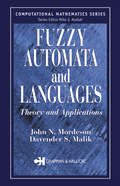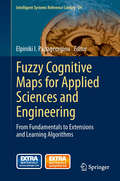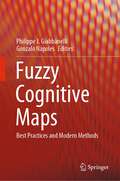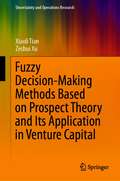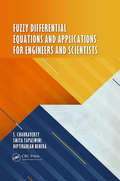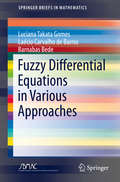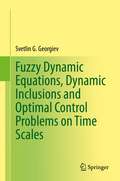- Table View
- List View
Funktionalanalysis: Topologische Raume, Funktionentheorie, Gewohnliche Differentialgleichungen, Maß- Und Integrationstheorie, Funktionalanalysis ... Literaturverzeichnis. (Springer-lehrbuch)
by Dirk WernerIn dieser leicht lesbaren und gründlichen Einführung in die Funktionalanalysis behandelt der Autor neben dem Standardlehrstoff auch Themen wie Interpolation linearer Operatoren, die Schwartzsche Distributionentheorie oder die GNS-Darstellung von C*-Algebren. Im Anhang ist das notwendige Wissen zu Lebesgue-Integralen sowie metrischen und topologischen Räumen zusammengefasst. Die korrigierte Neuauflage bietet über 200, zum Teil neue Aufgaben mit Anleitungen und Lösungen. Ideal als Vorlesungsgrundlage im Mathematik- und Physikstudium.
Funktionen für Höhlenmenschen und andere Anfänger: Koordinatensysteme zur Darstellung von Abhängigkeiten in der Mathematik (essentials)
by Jürgen BeetzFunktionen und Koordinatensysteme spielen in der Mathematik eine wichtige Rolle - und im täglichen Leben auch. Meist merken wir es gar nicht oder sind uns über die mathematischen Hintergründe von Grafiken gar nicht klar, die wir in den Medien sehen. Deswegen werden in diesem Essential die Grundlagen dieser bedeutenden Werkzeuge des Denkens dargestellt und ihre Verwendung illustriert. Da dazu auch ihr Missbrauch gehört, wird auch das Thema ,,Lügen mit Grafiken" behandelt: falsche Maßstäbe, Unterdrückung des Nullpunkts, unsinnige Extrapolationen und schließlich Fehler in den Zahlen selbst.
Funktionentheorie mehrerer Veränderlicher (Masterclass)
by Jörg EschmeierZiel dieses Lehrbuches ist es, einen verständlichen, möglichst direkten und in sich geschlossenen Zugang zu wichtigen Ergebnissen der mehrdimensionalen Funktionentheorie zu geben. Hierbei führt der Weg von elementaren Eigenschaften holomorpher Funktionen über analytische Mengen und Holomorphiebereiche bis hin zum Levi-Problem. Ein abschließendes Kapitel enthält mit der Konstruktion des mehrdimensionalen holomorphen Funktionalkalküls nach Shilov, Waelbroeck und Arens-Calderón und dem Satz von Arens-Royden wichtige Anwendungen auf die Theorie komplexer Banachalgebren. Zahlreiche Übungsaufgaben ergänzen den theoretischen Teil. Vorausgesetzt wird nur der Inhalt der Grundvorlesungen in Analysis und einer üblichen einsemestrigen Vorlesung über Funktionentheorie einer komplexen Veränderlichen. Das Buch richtet sich besonders an fortgeschrittene Bachelorstudierende oder Studierende eines Masterstudienganges und eignet sich bestens als Begleitlektüre zu einer Vorlesung oder auch zum Selbststudium.
Further Advances in Twistor Theory, Volume III: Curved Twistor Spaces
by L.J. Mason, L.P. Hughston, P.Z. Kobak and K. PulvererAlthough twistor theory originated as an approach to the unification of quantum theory and general relativity, twistor correspondences and their generalizations have provided powerful mathematical tools for studying problems in differential geometry, nonlinear equations, and representation theory. At the same time, the theory continues to offer pro
Further Advances in Twistor Theory: Volume II: Integrable Systems, Conformal Geometry and Gravitation (Chapman And Hall/crc Research Notes In Mathematics Ser. #232)
by L.J. Mason P.Z. Kobak L.P. HughstonTwistor theory is the remarkable mathematical framework that was discovered by Roger Penrose in the course of research into gravitation and quantum theory. It have since developed into a broad, many-faceted programme that attempts to resolve basic problems in physics by encoding the structure of physical fields and indeed space-time itself into the complex analytic geometry of twistor space. Twistor theory has important applications in diverse areas of mathematics and mathematical physics. These include powerful techniques for the solution of nonlinear equations, in particular the self-duality equations both for the Yang-Mills and the Einstein equations, new approaches to the representation theory of Lie groups, and the quasi-local definition of mass in general relativity, to name but a few. This volume and its companions comprise an abundance of new material, including an extensive collection of Twistor Newsletter articles written over a period of 15 years. These trace the development of the twistor programme and its applications over that period and offer an overview on the current status of various aspects of that programme. The articles have been written in an informal and easy-to-read style and have been arranged by the editors into chapter supplemented by detailed introductions, making each volume self-contained and accessible to graduate students and non-specialists from other fields. Volume II explores applications of flat twistor space to nonlinear problems. It contains articles on integrable or soluble nonlinear equations, conformal differential geometry, various aspects of general relativity, and the development of Penrose's quasi-local mass construction.
Further Adventures of Penrose the Mathematical Cat
by Theoni PappasPenrose, no ordinary cat, takes us on an adventurous tour of mathematical concepts and characters. Now he takes off again on new adventures.Join him as he .....discovers the mathematical rep-tiles...meets x, the mathematical actor..... is overpowered by a hoard of numbers ...stumbles onto the math rods... has a close encounter with Probably... discovers how 1+1!=2 ... helps Sorry Snowflake find its symmetry ... takes on Napier's hot rods ... crosses pi's path ... learns that mathematical doughnuts are not for dunking ...tantalizes, teases and perplexes us with his puzzles and games.These amusing and informative tales are just a few of many enchanting stories written in the author's captivating style that is sure to make mathematics entertaining. The reader will gain new insights and appreciation for mathematics and its many facets.
Further Developments in Fractals and Related Fields
by Julien Barral Stéphane SeuretThis volume, following in the tradition of a similar 2010 publication by the same editors, is an outgrowth of an international conference, "Fractals and Related Fields II," held in June 2011. The book provides readers with an overview of developments in the mathematical fields related to fractals, including original research contributions as well as surveys from many of the leading experts on modern fractal theory and applications. The chapters cover fields related to fractals such as: *geometric measure theory *ergodic theory *dynamical systems *harmonic and functional analysis *number theory *probability theory Further Developments in Fractals and Related Fields is aimed at pure and applied mathematicians working in the above-mentioned areas as well as other researchers interested in discovering the fractal domain. Throughout the volume, readers will find interesting and motivating results as well as new avenues for further research.
Future City Architecture for Optimal Living (Springer Optimization and Its Applications #102)
by Panos M. Pardalos Stamatina Th. RassiaThis book offers a wealth of interdisciplinary approaches to urbanization strategies in architecture centered on growing concerns about the future of cities and their impacts on essential elements of architectural optimization, livability, energy consumption and sustainability. It portrays the urban condition in architectural terms, as well as the living condition in human terms, both of which can be optimized by mathematical modeling as well as mathematical calculation and assessment.Special features include: • new research on the construction of future cities and smart cities• discussions of sustainability and new technologies designed to advance ideas to future city developmentsGraduate students and researchers in architecture, engineering, mathematical modeling, and building physics will be engaged by the contributions written by eminent international experts from a variety of disciplines including architecture, engineering, modeling, optimization, and related fields.
Future Communication, Information and Computer Science: Proceedings of the 2014 International Conference on Future Communication, Information and Computer Science (FCICS 2014), May 22-23, 2014, Beijing, China.
by Dawei ZhengThe 2014 International Conference on Future Communication, Information and Computer Science (FCICS 2014) was held May 22-23, 2014 in Beijing, China. The objective of FCICS 2014 was to provide a platform for researchers, engineers and academics as well as industrial professionals from all over the world to present their research results and development activities in Computer, Network and Information Technology and Communication Engineering.
Future Design for Creating a World Worth Inheriting
by Tatsuyoshi SaijoOur world stands at a critical crossroads. While world leaders wage wars and pursue aggression, humanity faces mounting "future failures" - burdens we're leaving for generations yet unborn. Scientists warn that carbon emissions, nitrogen cycles, and biodiversity loss have already reached dangerous tipping points. Yet we possess what we call "futurability" - the capacity to find joy in creating happiness for future generations, even at the expense of immediate gains. However, our current society isn't structured to nurture this vital human trait. Drawing inspiration from the Iroquois' seventh-generation principle, we've developed and tested innovative social mechanisms through rigorous laboratory experiments and real-world applications. This book, "Future Design for Creating a World Worth Inheriting," presents our vision and practical framework for redesigning society to activate our collective futurability. Through years of research and implementation, we've created concrete solutions that can transform how we make decisions about our shared future. Join us in this crucial endeavor to create a world our descendants will thank us for - a world truly worth inheriting.
Future Design: Incorporating Preferences of Future Generations for Sustainability (Economics, Law, and Institutions in Asia Pacific)
by Tatsuyoshi SaijoThis book discusses imaginary future generations and how current decision-making will influence those future generations. Markets and democracies focus on the present and therefore tend to make us forget that we are living in the present, with ancestors preceding and descendants succeeding us. Markets are excellent devices to equate supply and demand in the short term, but not for allocating resources between current and future generations, since future generations do not exist yet. Democracy is also not “applicable” for future generations, since citizens vote for candidates who will serve members of their, i.e., the current, generation. In order to overcome these shortcomings, the authors discusses imaginary future generations and future ministries in the context of current decision-making in fields such as the environment, urban management, forestry, water management, and finance. The idea of imaginary future generations comes from the Native American Iroquois, who had strong norms that compelled them to incorporate the interests of people seven generations ahead when making decisions.
Future Sustainable Ecosystems: Complexity, Risk, and Uncertainty (Chapman & Hall/CRC Applied Environmental Statistics #11)
by Nathaniel K NewlandsFuture Sustainable Ecosystems: Complexity, Risk, Uncertainty provides an interdisciplinary, integrative overview of environmental problem-solving using statistics. It shows how statistics can be used to solve diverse environmental and socio-economic problems involving food, water, energy scarcity, and climate change risks. It synthesizes interdisciplinary theory, concepts, definitions, models and findings involved in complex global sustainability problem-solving, making it an essential guide and reference. It includes real-world examples and applications making the book accessible to a broader interdisciplinary readership. Discussions include a broad, integrated perspective on sustainability, integrated risk, multi-scale changes and impacts taking place within ecosystems worldwide. State-of-the-art statistical techniques, including Bayesian hierarchical, spatio-temporal, agent-based and game-theoretic approaches are explored. The author then focuses on the real-world integration of observational and experimental data and its use within statistical models.
Future Vision and Trends on Shapes, Geometry and Algebra
by Raffaele Amicis Giuseppe ContiMathematical algorithms are a fundamental component of Computer Aided Design and Manufacturing (CAD/CAM) systems. This book provides a bridge between algebraic geometry and geometric modelling algorithms, formulated within a computer science framework. Apart from the algebraic geometry topics covered, the entire book is based on the unifying concept of using algebraic techniques - properly specialized to solve geometric problems - to seriously improve accuracy, robustness and efficiency of CAD-systems. It provides new approaches as well as industrial applications to deform surfaces when animating virtual characters, to automatically compare images of handwritten signatures and to improve control of NC machines. This book further introduces a noteworthy representation based on 2D contours, which is essential to model the metal sheet in industrial processes. It additionally reviews applications of numerical algebraic geometry to differential equations systems with multiple solutions and bifurcations. Future Vision and Trends on Shapes, Geometry and Algebra is aimed specialists in the area of mathematics and computer science on the one hand and on the other hand at those who want to become familiar with the practical application of algebraic geometry and geometric modelling such as students, researchers and doctorates.
Future-Proofing the Judiciary: Preparing for Demographic Change (Palgrave Socio-Legal Studies)
by Brian OpeskinThis book reinvigorates the field of socio-legal inquiry examining the relationship between law and demography. Originally conceived as 'population law' in the 1960s following a growth in population and a use of law to temper population growth, this book takes a new approach by examining how population change can affect the legal system, rather than the converse. It analyses the impact of demographic change on the judicial system, with a geographic focus on Australian courts but with global insights and it raises questions about institutional structures. Through four case studies, it examines how demographic change impacts on the judicial system and how should the judicial system adapt to embody a greater preparedness for the demographic changes that lie ahead? It makes recommendations for reform and speaks to applied demographers, socio-legal scholars, and those interested in judicial institutions.
Futures of the Western Balkans: Fragmentation and Integration in the Region and Beyond (SpringerBriefs in Political Science)
by Marco ZoppiThis Brief provides a survey of key political, social, and economic issues affecting the Western Balkans region. Taking a two-pronged conceptual approach focusing on fragmentation and integration, the volume highlights commonalities and differences in a number of simultaneous dynamics currently characterizing the region: Europeanization and EU access, market integration, and migration and socio-demographic transformations. Stressing the interconnectedness of these issues, the volume synthesizes key questions for the future of the region, such as the relationship between socio-demographic trends and economic development, the effects of depopulation on further EU integration, and the economic and political repercussions of enhanced intra-regional trade. Explicitly interdisciplinary, this Brief will be useful for researchers and students specializing in the Balkans and Western Balkans, post-socialist countries, European affairs, enlargement, foreign policy, international relations, regional studies, economics, economic transition, and socio-demographics.
Fuzziness in Information Systems
by Miroslav HudecThis book is an essential contribution to the description of fuzziness in information systems. Usually users want to retrieve data or summarized information from a database and are interested in classifying it or building rule-based systems on it. But they are often not aware of the nature of this data and/or are unable to determine clear search criteria. The book examines theoretical and practical approaches to fuzziness in information systems based on statistical data related to territorial units. Chapter 1 discusses the theory of fuzzy sets and fuzzy logic to enable readers to understand the information presented in the book. Chapter 2 is devoted to flexible queries and includes issues like constructing fuzzy sets for query conditions, and aggregation operators for commutative and non-commutative conditions, while Chapter 3 focuses on linguistic summaries. Chapter 4 presents fuzzy logic control architecture adjusted specifically for the aims of business and governmental agencies, and shows fuzzy rules and procedures for solving inference tasks. Chapter 5 covers the fuzzification of classical relational databases with an emphasis on storing fuzzy data in classical relational databases in such a way that existing data and normal forms are not affected. This book also examines practical aspects of user-friendly interfaces for storing, updating, querying and summarizing. Lastly, Chapter 6 briefly discusses possible integration of fuzzy queries, summarization and inference related to crisp and fuzzy databases. The main target audience of the book is researchers and students working in the fields of data analysis, database design and business intelligence. As it does not go too deeply into the foundation and mathematical theory of fuzzy logic and relational algebra, it is also of interest to advanced professionals developing tailored applications based on fuzzy data.
Fuzzy Analytic Hierarchy Process
by Ali Emrouznejad William HoThis book is the first in the literature to present the state of the art and some interesting and relevant applications of the Fuzzy Analytic Hierarchy Process (FAHP). The AHP is a conceptually and mathematically simple, easily implementable, yet extremely powerful tool for group decision making and is used around the world in a wide variety of decision situations, in fields such as government, business, industry, healthcare, and education. The aim of this book is to study various fuzzy methods for dealing with the imprecise and ambiguous data in AHP. Features: First book available on FAHP. Showcases state-of-the-art developments. Contains several novel real-life applications. Provides useful insights to both academics and practitioners in making group decisions under uncertainty This book provides the necessary background to work with existing fuzzy AHP models. Once the material in this book has been mastered, the reader will be able to apply fuzzy AHP models to his or her problems for making decisions with imprecise data.
Fuzzy Arbitrary Order System: Fuzzy Fractional Differential Equations and Applications
by Snehashish Chakraverty Smita Tapaswini Diptiranjan BeheraPresents a systematic treatment of fuzzy fractional differential equations as well as newly developed computational methods to model uncertain physical problems Complete with comprehensive results and solutions, Fuzzy Arbitrary Order System: Fuzzy Fractional Differential Equations and Applications details newly developed methods of fuzzy computational techniquesneeded to model solve uncertainty. Fuzzy differential equations are solved via various analytical andnumerical methodologies, and this book presents their importance for problem solving, prototypeengineering design, and systems testing in uncertain environments. In recent years, modeling of differential equations for arbitrary and fractional order systems has been increasing in its applicability, and as such, the authors feature examples from a variety of disciplines to illustrate the practicality and importance of the methods within physics, applied mathematics, engineering, and chemistry, to name a few. The fundamentals of fractional differential equations and the basic preliminaries of fuzzy fractional differential equations are first introduced, followed by numerical solutions, comparisons of various methods, and simulated results. In addition, fuzzy ordinary, partial, linear, and nonlinear fractional differential equations are addressed to solve uncertainty in physical systems. In addition, this book features: * Basic preliminaries of fuzzy set theory, an introduction of fuzzy arbitrary order differential equations, and various analytical and numerical procedures for solving associated problems * Coverage on a variety of fuzzy fractional differential equations including structural, diffusion, and chemical problems as well as heat equations and biomathematical applications * Discussions on how to model physical problems in terms of nonprobabilistic methods and provides systematic coverage of fuzzy fractional differential equations and its applications * Uncertainties in systems and processes with a fuzzy concept Fuzzy Arbitrary Order System: Fuzzy Fractional Differential Equations and Applications is an ideal resource for practitioners, researchers, and academicians in applied mathematics, physics, biology, engineering, computer science, and chemistry who need to model uncertain physical phenomena and problems. The book is appropriate for graduate-level courses on fractional differential equations for students majoring in applied mathematics, engineering, physics, and computer science. Snehashish Chakraverty, PhD, is Professor and Head of the Department of Mathematics at the National Institute of Technology, Rourkela in India. The author of five books and approximately 140 journal articles, his research interests include mathematical modeling, machine intelligence, uncertainty modeling, numerical analysis, and differential equations. Smita Tapaswini, PhD, is Assistant Professor in the Department of Mathematics at the Kalinga Institute of Industrial Technology University in India and is also Post-Doctoral Fellow at the College of Mathematics and Statistics at Chongqing University in China. Her research interests include fuzzy differential equations, fuzzy fractional differential equations, and numerical analysis. Diptiranjan Behera, PhD, is Post-Doctoral Fellow at the Institute of Reliability Engineering in the School of Mechatronics Engineering at the University of Electronic Science and Technology of China. His current research interests include interval and fuzzy mathematics, fuzzy finite element methods, and fuzzy structural analysis.
Fuzzy Automata and Languages: Theory and Applications
by John N. Mordeson Davender S. MalikFuzzy Automata Theory offers the first in-depth treatment of the theory and mathematics of fuzzy automata and fuzzy languages. It effectively compares and contrasts the different approaches used in fuzzy mathematics and automata and includes complete proofs of the theoretical results presented. More than 60 figures and 125 examples illustrate the results, and exercises in each chapter serve not only to test understanding, but also to present material not covered in detail within the text. Although the book is theoretical in nature, the authors also discuss applications in a variety of fields, including databases, medicine, learning systems, and pattern recognition.
Fuzzy Cognitive Maps for Applied Sciences and Engineering
by Elpiniki I. PapageorgiouFuzzy Cognitive Maps (FCM) constitute cognitive models in the form of fuzzy directed graphs consisting of two basic elements: the nodes, which basically correspond to "concepts" bearing different states of activation depending on the knowledge they represent, and the "edges" denoting the causal effects that each source node exercises on the receiving concept expressed through weights. Weights take values in the interval [-1,1], which denotes the positive, negative or neutral causal relationship between two concepts. An FCM can be typically obtained through linguistic terms, inherent to fuzzy systems, but with a structure similar to the neural networks, which facilitates data processing, and has capabilities for training and adaptation. During the last 10 years, an exponential growth of published papers in FCMs was followed showing great impact potential. Different FCM structures and learning schemes have been developed, while numerous studies report their use in many contexts with highly successful modeling results. The aim of this book is to fill the existing gap in the literature concerning fundamentals, models, extensions and learning algorithms for FCMs in knowledge engineering. It comprehensively covers the state-of-the-art FCM modeling and learning methods, with algorithms, codes and software tools, and provides a set of applications that demonstrate their various usages in applied sciences and engineering.
Fuzzy Cognitive Maps: Best Practices and Modern Methods
by Philippe J. Giabbanelli Gonzalo NápolesThis book starts with the rationale for creating an FCM by contrast to other techniques for participatory modeling, as this rationale is a key element to justify the adoption of techniques in a research paper. Fuzzy cognitive mapping is an active research field with over 20,000 publications devoted to externalizing the qualitative perspectives or “mental models” of individuals and groups. Since the emergence of fuzzy cognitive maps (FCMs) back in the 80s, new algorithms have been developed to reduce bias, facilitate the externalization process, or efficiently utilize quantitative data via machine learning. It covers the development of an FCM with participants through a traditional in-person setting, drawing from the experience of practitioners and highlighting solutions to commonly encountered challenges. The book continues with introducing principles of simulations with FCMs as a tool to perform what-if scenario analysis, while extending those principles to more elaborated simulation scenarios where FCMs and agent-based modeling are combined. Once an FCM model is obtained, the book then details the analytical tools available for practitioners (e.g., to identify the most important factors) and provides examples to aid in the interpretation of results. The discussion concerning relevant extensions is equally pertinent, which are devoted to increasing the expressiveness of the FCM formalism in problems involving uncertainty. The last four chapters focus on building FCM models from historical data. These models are typically needed when facing multi-output prediction or pattern classification problems. In that regard, the book smoothly guides the reader from simple approaches to more elaborated algorithms, symbolizing the noticeable progress of this field in the last 35 years. Problems, recent references, and functional codes are included in each chapter to provide practice and support further learning from practitioners and researchers.
Fuzzy Decision-Making Methods Based on Prospect Theory and Its Application in Venture Capital (Uncertainty and Operations Research)
by Zeshui Xu Xiaoli TianThis book gives a thorough and systematic introduction to the latest research results about fuzzy decision-making method based on prospect theory. It includes eight chapters: Introduction, Intuitionistic fuzzy MADM based on prospect theory, QUALIFLEX based on prospect theory with probabilistic linguistic information, Group PROMETHEE based on prospect theory with hesitant fuzzy linguistic information, Prospect consensus with probabilistic hesitant fuzzy preference information, Improved TODIM based on prospect theory and the improved TODIM with probabilistic hesitant fuzzy information, etc. This book is suitable for the researchers in the fields of fuzzy mathematics, operations research, behavioral science, management science and engineering, etc. It is also useful as a textbook for postgraduate and senior-year undergraduate students of the relevant professional institutions of higher learning.
Fuzzy Differential Equations and Applications for Engineers and Scientists
by Smita Tapaswini Diptiranjan Behera S. ChakravertyDifferential equations play a vital role in the modeling of physical and engineering problems, such as those in solid and fluid mechanics, viscoelasticity, biology, physics, and many other areas. In general, the parameters, variables and initial conditions within a model are considered as being defined exactly. In reality there may be only vague, imprecise or incomplete information about the variables and parameters available. This can result from errors in measurement, observation, or experimental data; application of different operating conditions; or maintenance induced errors. To overcome uncertainties or lack of precision, one can use a fuzzy environment in parameters, variables and initial conditions in place of exact (fixed) ones, by turning general differential equations into Fuzzy Differential Equations ("FDEs"). In real applications it can be complicated to obtain exact solution of fuzzy differential equations due to complexities in fuzzy arithmetic, creating the need for use of reliable and efficient numerical techniques in the solution of fuzzy differential equations. These include fuzzy ordinary and partial, fuzzy linear and nonlinear, and fuzzy arbitrary order differential equations. This unique work?provides a new direction for the reader in the use of basic concepts of fuzzy differential equations, solutions and its applications. It can serve as an essential reference work for students, scholars, practitioners, researchers and academicians in engineering and science who need to model uncertain physical problems.
Fuzzy Differential Equations in Various Approaches
by Luciana Takata Gomes Laécio Carvalho de Barros Barnabas BedeThis book may be used as reference for graduate students interested in fuzzy differential equations and researchers working in fuzzy sets and systems, dynamical systems, uncertainty analysis, and applications of uncertain dynamical systems. Beginning with a historical overview and introduction to fundamental notions of fuzzy sets, including different possibilities of fuzzy differentiation and metric spaces, this book moves on to an overview of fuzzy calculus thorough exposition and comparison of different approaches. Innovative theories of fuzzy calculus and fuzzy differential equations using fuzzy bunches of functions are introduced and explored. Launching with a brief review of essential theories, this book investigates both well-known and novel approaches in this field; such as the Hukuhara differentiability and its generalizations as well as differential inclusions and Zadeh's extension. Through a unique analysis, results of all these theories are examined and compared.
Fuzzy Dynamic Equations, Dynamic Inclusions, and Optimal Control Problems on Time Scales
by Svetlin G. GeorgievThe theory of dynamic equations has many interesting applications in control theory, mathematical economics, mathematical biology, engineering and technology. In some cases, there exists uncertainty, ambiguity, or vague factors in such problems, and fuzzy theory and interval analysis are powerful tools for modeling these equations on time scales. The aim of this book is to present a systematic account of recent developments; describe the current state of the useful theory; show the essential unity achieved in the theory fuzzy dynamic equations, dynamic inclusions and optimal control problems on time scales; and initiate several new extensions to other types of fuzzy dynamic systems and dynamic inclusions. The material is presented in a highly readable, mathematically solid format. Many practical problems are illustrated, displaying a wide variety of solution techniques. The book is primarily intended for senior undergraduate students and beginning graduate students of engineering and science courses. Students in mathematical and physical sciences will find many sections of direct relevance.
